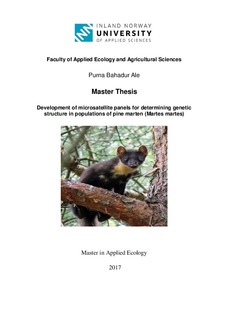| dc.description.abstract | The population genetic structure of the Norwegian pine marten (Martes martes) is poorly understood. Genetic study of this species is challenging due to their elusive nature and limited available information. In the present study, samples were collected by using non-invasive genetic techniques and genotyping individual pine marten using microsatellite markers. The objectives of my study were primarily to develop microsatellite panel from the microsatellite markers previously used for other mustelid species and secondarily to evaluate DNA extraction methods from different biological samples. DNA was successfully extracted from fresh muscle tissue, hair and dry skin with fur (samples from museum specimen). However, the quality of DNA extracted from hair samples and museum specimen samples was considerably low. For the development of the microsatellite panels, 18 microsatellite markers were successfully grouped into 3 PCR multiplex panels including one sex identifying marker containing 4-8 microsatellite loci in each multiplex panel. One of the fresh muscle tissue sample successfully amplified 100 % microsatellite loci used in this study. Out of the other remaining 6 tissues including frozen tissue samples analyzed, 79 % of the microsatellite loci were amplified on genotyping while only 32 % of the microsatellite loci were amplified in 8 hair samples. On the other hand, museum specimen sample did not amplify microsatellite loci at all. The genotyping success rate of hair samples was found to be significantly lower compared to tissue samples. However, due to a smaller size of hair samples and degradation of DNA extracted from hair samples, I could not tests sufficient to draw a clear conclusion about genotyping success rate of hair samples. The genotyping result showed that all the microsatellite loci had variation in alleles ranging from 2 to 11 alleles per locus. The ISOLATE-II Genomic Kit and the Chelex 100 protocol yielded amplifiable DNA from tissues and hair samples respectively among the methods used for the DNA extraction. In conclusion, this developed microsatellite panel of microsatellite markers and PCR protocol can be used further for the population genetics study of pine marten in Norway. | nb_NO |
